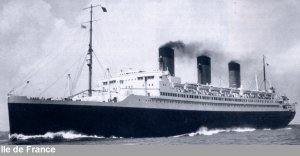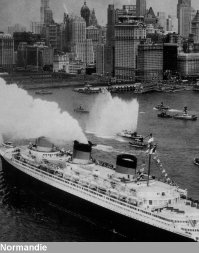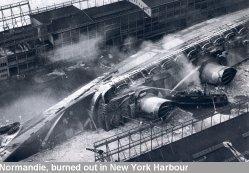

|
       |  The French Line or, Compagnie Generale Transatlantique, didn’t enter the serious Atlantic superliner competition until after the first World War. Before the war, the French Line operated a collection of small and chic liners, the largest and most famous of which was the France. The ship was dubbed as "The Chateau of the Atlantic" because of its sumptuous interiors modelled after Louis XIV’s palace at Versailles. The Paris, was one of the first new large liners constructed after the war. At 34,500 tons, it would be the French Lines largest ship to date and it’s splendid interiors would suggest some of the luxury that was to follow.
In 1927, the French Line would commission of the most celebrated liners ever built. She would become renown, not for her size or technological sophistication, but for her revolutionary interiors. The Ile de France, would be the first ship to bring art deco to the high seas. Her interiors were bold and startling to some, unlike her peers, she did not copy landslide establishments, but would invent a radically new style. In creating the Ile de France, company chairman Jean Piaz decreed to his designers, "To live is not to copy, it is to create". Americans and the young, particularly fell under her spell, they relaxed in lounges decorated by Jeanniot, Bouchard and Saupique, walked around statues by Baudry and dined in a vast seven hundred seat dining room, or at least in first class. The ship boasted other The French Line or, Compagnie Generale Transatlantique, didn’t enter the serious Atlantic superliner competition until after the first World War. Before the war, the French Line operated a collection of small and chic liners, the largest and most famous of which was the France. The ship was dubbed as "The Chateau of the Atlantic" because of its sumptuous interiors modelled after Louis XIV’s palace at Versailles. The Paris, was one of the first new large liners constructed after the war. At 34,500 tons, it would be the French Lines largest ship to date and it’s splendid interiors would suggest some of the luxury that was to follow.
In 1927, the French Line would commission of the most celebrated liners ever built. She would become renown, not for her size or technological sophistication, but for her revolutionary interiors. The Ile de France, would be the first ship to bring art deco to the high seas. Her interiors were bold and startling to some, unlike her peers, she did not copy landslide establishments, but would invent a radically new style. In creating the Ile de France, company chairman Jean Piaz decreed to his designers, "To live is not to copy, it is to create". Americans and the young, particularly fell under her spell, they relaxed in lounges decorated by Jeanniot, Bouchard and Saupique, walked around statues by Baudry and dined in a vast seven hundred seat dining room, or at least in first class. The ship boasted other  distinctions such as, the first ocean-going, consecrated Roman Catholic chapel and at the time the longest bar then afloat. The Ile de France even found its way into several popular songs of the thirties, including Noel Coward’s "These Foolish Things" and also was the backdrop for the film "Gentlemen Prefer Blondes", albeit, as the Ile de Paris! By 1935, she carried more first-class travellers than any other liner afloat, all she lacked was a worthy running mate. (Wall, 1995:112).
In spite of the tough economic times, the French government would help to sponsor the largest liner ever built. She would be built at a cost of $60,000,000 and would be dubbed as France’s "floating debt". Launched from the shipbuilding yards at Saint-Nazarie on 29th of October 1932, the Normandie would assume the title of first ship to exceed 70,000 tons and the first ship over 1,000ft. However, when the French heard of Cunards plans to build two ships over 80,000 tons, they added a large, but unnecessary deckhouse which brought her tonnage above the 80,000 ton mark. Like the Ile de France, the Normandie’s interiors would be extraordinarily luxurious, but unlike the Ile’s dated external features, the Normandie would influence ocean liner design for decades to come. Her revolutionary appearance was in part the product of a Russian emigre named Vladimir Yourkevitch. Yourkevitch had designed warships for the Russian navy, credentials good enough to convince the directors of the French Line to give his then radical hull design proposals a try. Below the waterline Normandie would feature a bulbous distinctions such as, the first ocean-going, consecrated Roman Catholic chapel and at the time the longest bar then afloat. The Ile de France even found its way into several popular songs of the thirties, including Noel Coward’s "These Foolish Things" and also was the backdrop for the film "Gentlemen Prefer Blondes", albeit, as the Ile de Paris! By 1935, she carried more first-class travellers than any other liner afloat, all she lacked was a worthy running mate. (Wall, 1995:112).
In spite of the tough economic times, the French government would help to sponsor the largest liner ever built. She would be built at a cost of $60,000,000 and would be dubbed as France’s "floating debt". Launched from the shipbuilding yards at Saint-Nazarie on 29th of October 1932, the Normandie would assume the title of first ship to exceed 70,000 tons and the first ship over 1,000ft. However, when the French heard of Cunards plans to build two ships over 80,000 tons, they added a large, but unnecessary deckhouse which brought her tonnage above the 80,000 ton mark. Like the Ile de France, the Normandie’s interiors would be extraordinarily luxurious, but unlike the Ile’s dated external features, the Normandie would influence ocean liner design for decades to come. Her revolutionary appearance was in part the product of a Russian emigre named Vladimir Yourkevitch. Yourkevitch had designed warships for the Russian navy, credentials good enough to convince the directors of the French Line to give his then radical hull design proposals a try. Below the waterline Normandie would feature a bulbous forefoot and a pear-shaped middle that produced a hull of unprecedented hyprodynamic efficiency, yielding almost no bow wave and leaving a thin flat wake. Her dramatic clipper-like bow contributed a sense of the majestic and clean sweeping superstructure would provide acres of uncluttered deck-space. A giant teak coloured whaleback concealed the foredeck and its clutter of ropes and chains, winches and capstans, ending halfway to the bridge. Her aerodynamic funnels and superstructure, would leave her contemporaries looking dated and stayed. In May of 1935, her interiors were revealed to an expectant public for the first time.
The Normandie’s interiors were on a larger and grander scale the famed Ile de France. To provide the ship with an unprecedented sense of space, Normandie’s designers split the uptake of her tow working funnels and run them up the outside of the superstructure. The grand salon, rose to a vaulted peak three decks high, was only one of a series of interconnected rooms and avenues on the promenade deck, they formed an uninterrupted concourse of unprecedented length with the sliding wooden panel between the grand salon and the smoking room was open. Attention to every detail had been considered, to make the Normandie, a floating showcase for France, truly a ship of state. Among her other amenities, were a full-sized theatre, grille café, first class staterooms which boasted forty distinct designs, gymnasium, chapel, reception rooms and more. forefoot and a pear-shaped middle that produced a hull of unprecedented hyprodynamic efficiency, yielding almost no bow wave and leaving a thin flat wake. Her dramatic clipper-like bow contributed a sense of the majestic and clean sweeping superstructure would provide acres of uncluttered deck-space. A giant teak coloured whaleback concealed the foredeck and its clutter of ropes and chains, winches and capstans, ending halfway to the bridge. Her aerodynamic funnels and superstructure, would leave her contemporaries looking dated and stayed. In May of 1935, her interiors were revealed to an expectant public for the first time.
The Normandie’s interiors were on a larger and grander scale the famed Ile de France. To provide the ship with an unprecedented sense of space, Normandie’s designers split the uptake of her tow working funnels and run them up the outside of the superstructure. The grand salon, rose to a vaulted peak three decks high, was only one of a series of interconnected rooms and avenues on the promenade deck, they formed an uninterrupted concourse of unprecedented length with the sliding wooden panel between the grand salon and the smoking room was open. Attention to every detail had been considered, to make the Normandie, a floating showcase for France, truly a ship of state. Among her other amenities, were a full-sized theatre, grille café, first class staterooms which boasted forty distinct designs, gymnasium, chapel, reception rooms and more.  To the delight of the French, the Normandie would win the Blue Riband on May 29th, 1935, on her maiden voyage, covering the distance in four days, three hours and two minutes, averaging fractionally under 30 knots for the entire crossing. On August 31st, 1936, Normandie would lose the record to the Queen Mary, but briefly regained the record in 1937, but the Queen Mary would take the honour permanently from the Normandie. The Queen Mary would also win out in profits, in spite of her beauty, the Normandie would sail on average, only 60% full. The reasons for this is open to conjecture, but it has been suggest that Normandie’s interiors were too bold and modern for more ordinary passengers. (Archbold, Ballard, Marschall, 1997:155-165).
World War two would cut short the duel between the Normandie and the Queen Mary. The ships would find themselves moored beside each other at their respective piers in New York. In March of 1940, the Queen Elizabeth, would join the Normandie and the Mary and for two weeks the three largest ships yet built, would be lined-up together. The Queen Mary and Elizabeth would go to war, while the Normandie would languish in New York, costing her owners $1,000 per day in port charges. When America entered the war in December 1941, the Normandie was taken over by the United States Navy to become a trooper. She was renamed U.S.S. Lafayette, named after the great eighteenth century Franco-American statesman. Due to a very tight schedule, security and safety restrictions were somewhat lax. When almost complete a worker removing a lighted pillar in her grand salon, with an oxy-acetylene torch ignited a pile of kapok life jackets. 3,000 workers were evacuated and casualties were limited to only one. However, the fire raged, attended by the New York fire brigade. The tons of water poured into the ship caused her to develop a dangerous list. Twelve house after the fire started, the Normandie To the delight of the French, the Normandie would win the Blue Riband on May 29th, 1935, on her maiden voyage, covering the distance in four days, three hours and two minutes, averaging fractionally under 30 knots for the entire crossing. On August 31st, 1936, Normandie would lose the record to the Queen Mary, but briefly regained the record in 1937, but the Queen Mary would take the honour permanently from the Normandie. The Queen Mary would also win out in profits, in spite of her beauty, the Normandie would sail on average, only 60% full. The reasons for this is open to conjecture, but it has been suggest that Normandie’s interiors were too bold and modern for more ordinary passengers. (Archbold, Ballard, Marschall, 1997:155-165).
World War two would cut short the duel between the Normandie and the Queen Mary. The ships would find themselves moored beside each other at their respective piers in New York. In March of 1940, the Queen Elizabeth, would join the Normandie and the Mary and for two weeks the three largest ships yet built, would be lined-up together. The Queen Mary and Elizabeth would go to war, while the Normandie would languish in New York, costing her owners $1,000 per day in port charges. When America entered the war in December 1941, the Normandie was taken over by the United States Navy to become a trooper. She was renamed U.S.S. Lafayette, named after the great eighteenth century Franco-American statesman. Due to a very tight schedule, security and safety restrictions were somewhat lax. When almost complete a worker removing a lighted pillar in her grand salon, with an oxy-acetylene torch ignited a pile of kapok life jackets. 3,000 workers were evacuated and casualties were limited to only one. However, the fire raged, attended by the New York fire brigade. The tons of water poured into the ship caused her to develop a dangerous list. Twelve house after the fire started, the Normandie would snap her moorings and capsize onto her starboard side. The Navy would salvaged the wreck at the cost of $4.74 million and by September 1943 was again afloat. But on inspection of her hull in dry-dock, it was discovered her hull was badly damaged and it was prohibitive to refit her. The Normandie, once the pride of the Atlantic, was sent for scrap.
The other large French Line ship the Paris, caught fire in her Le Havre pier just prior to the second World War, and eventually capsized. When at the end of the second World War, the German liner the Europa was ceded to France as the Liberte, she broke from her moorings and struck the wreck of the Paris, which had lain un-salvaged during the war. The French line would operate the reconditioned Liberte and Europa in the post-war years. Both ships would eventually be scrapped, the Liberte going quietly, but the Ile de France, would have a spectacular swan song. The ship would be the star attraction of a film called "The Last Voyage", a disaster film where parts of the ship were systematically blown-up, then the Ile would be sunk. After she would be raised and sent for scrap. The French Line would replace the Liberte with a new ship, the France of 1962. She initially proved popular on the Atlantic route, with her renowned French cuisine, and distinctive winged funnels. But when its government subsidy was removed in 1974, she was withdrawn. In a quirk of fate, the France still sails on today, renamed the Norway. ...(bibliography)... (french liners gallery). would snap her moorings and capsize onto her starboard side. The Navy would salvaged the wreck at the cost of $4.74 million and by September 1943 was again afloat. But on inspection of her hull in dry-dock, it was discovered her hull was badly damaged and it was prohibitive to refit her. The Normandie, once the pride of the Atlantic, was sent for scrap.
The other large French Line ship the Paris, caught fire in her Le Havre pier just prior to the second World War, and eventually capsized. When at the end of the second World War, the German liner the Europa was ceded to France as the Liberte, she broke from her moorings and struck the wreck of the Paris, which had lain un-salvaged during the war. The French line would operate the reconditioned Liberte and Europa in the post-war years. Both ships would eventually be scrapped, the Liberte going quietly, but the Ile de France, would have a spectacular swan song. The ship would be the star attraction of a film called "The Last Voyage", a disaster film where parts of the ship were systematically blown-up, then the Ile would be sunk. After she would be raised and sent for scrap. The French Line would replace the Liberte with a new ship, the France of 1962. She initially proved popular on the Atlantic route, with her renowned French cuisine, and distinctive winged funnels. But when its government subsidy was removed in 1974, she was withdrawn. In a quirk of fate, the France still sails on today, renamed the Norway. ...(bibliography)... (french liners gallery).FastCounter by bCentral People have visited this page since; 11/6/96 | Ocean Liners | Links | View Guestbook | Sign Guestbook | E-mail | |